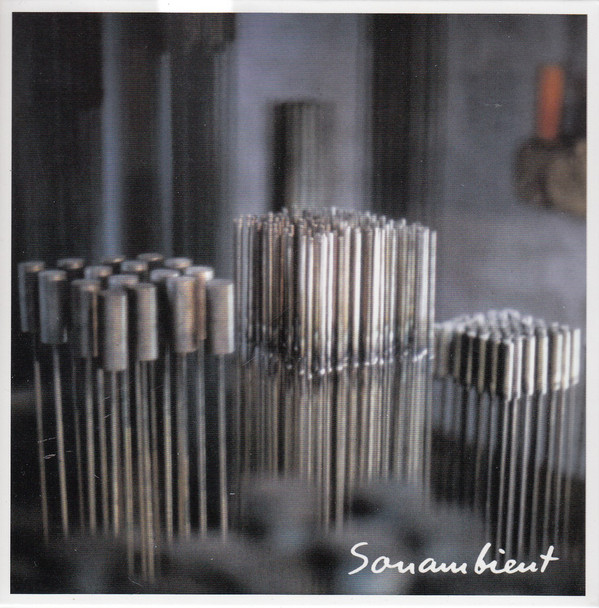
 |
|
 |
Format: LP Label & Cat.Number: Sonambient FW 1033LP Release Year: 2016 Note: the legendary SONAMBIENT label has been re-activated, this is the first release with previously unheard/unreleased material from the BERTOIA archive! => recorded 1971 and 1973, these were directly mastered from the original 1/4" tapes... deep metallic vibrations and reverberations of his sculptures and gongs (about 100 of them were kept in the BERTOIA barn in the woods of Pennsylvania), stunning recording quality !! finally re-pressed !
Price (incl. 19% VAT): €23.00 Warning: Currently we do not have this album in stock!
More Info"After nearly 40 years of silence, Harry Bertoia's Sonambient label has been resurrected in order to release the best of Bertoia's unheard recordings from his recently preserved archive of 1/4" tapes. "Clear Sounds" b/w "Perfetta" was cut straight from the original reels and is a true analog pressing. These two pieces were selected for their minimal, meditative and lush harmonic qualities; lacking in the abundance of dynamics and contrasts found on the original Sonambient records, these pieces show another approach to performance. Slow washes of shimmering metallic sculpture rustle thickly like the leaves of a white birch or tall grass in the summer sun. Gorgeous harmonics hover overhead, making audible measurements of the length and purity of Bertoia's metal rod sculptures. Both Harry Bertoia and his brother Oreste composed extensively in the Sonambient barn deep in the woods of rural Pennsylvania where Harry kept over 100 Sonambient sculptures and gongs. The first Sonambient LP Bellissima Bellissima Bellissima / Nova, released in 1970, contains a Harry Bertoia composition on side A and an Oreste Bertoia composition on side B. As an homage to the original Sonambient LP, "Clear Sounds" is a Harry Bertoia piece from June 30, 1973 and "Perfetta" is an Oreste Bertoia piece from June 28, 1971. Harry Bertoia first came into artistic prominence in the late 1930s and his sculptural, ergomonic chairs were soon modernist furniture classics. Inspired by the resonant sounds emanating from metals as he worked them and encouraged by his brother Oreste, whose passion was music, Harry restored a fieldstone "Pennsylvania Dutch" barn as the home for this experiment in sounding sculptures which he had begun in the 1950s. Bertoia was an obsessive composer and relentless experimenter, often working late into the night and accumulating hundreds of tapes of his best performances; Oreste, too, would explore and record the sculptures's sounds during his annual visits to his brother's home in rural Pennsylvania. Over nearly twenty years, adding, culling and rearranging, Bertoia carefully selected nearly 100 harmonious pieces ranging in height from under a foot to more than fifteen feet. Learning by experimentation was common for Bertoia and he mastered the art of tape recording, turning the Sonambient barn into a sound studio with four overhead microphones hanging from the rafters in a square formation. He would experiment with overdubbing by performing along to previous recordings, constantly improving his methods while also honing his performance skills." [label info]"Harry Bertoia came to the research and development of sound sculptures through the success of his furniture design. The chairs he crafted for Knoll in the '50s were fashioned from simple grids of steel rods molded into ergonomic forms. These became iconic of the mid-century modern aesthetic, still beloved by many to this day. By the early '60, Bertoia turned his attention full-time to sculpture using many of the same types of steel rods from his furniture, often stacking and bundling these in geometric shapes. Through the use of these rods in both furniture and sculpture, he became intimately familiar with the sounds of his materials banging and clattering together. Thus, he began producing sculptures that were intended to make sound by affixing parallel rods of to a soundboard, harnessing the resonant shimmer and glisten of his material. These sound sculptures proliferated in his large barn of a studio, with Bertoia tinkering with the possibility of recording these sculptures in the context of composed interventions. These sounds are haunted and ethereal with lengthy acoustic decay on the metallic timbres, showcasing a complexity of sustained tone that were rarely matched outside the electro-acoustic drones of Organum and Andrew Chalk. Throughout the '70s, he self-published 11 albums under his own Sonambient imprint, all of which had been reissued through Important on a CD box set earlier this year. Somanbient unearths two previously unpublished recordings from the Bertoia archive, with "Clear Sounds" dating from 1973 and "Perfetta" from 1971. Both pieces are emblematic of the Bertoia sound: lush, harmonic passages of glistening tones that billow, collapse and dissolve as manifestations of organic yet hallowed sound. A necessary rediscovery to one of the great American sound sculptors of the 20th Century." [Stranded] |
| © 2007 Drone Records | | Celler Strasse 33, 28205 Bremen, Germany | Privacy and cookies policy | Impressum / Allgemeine Geschaftsbedingungen / Haftungsausschluss | Links to the scene |